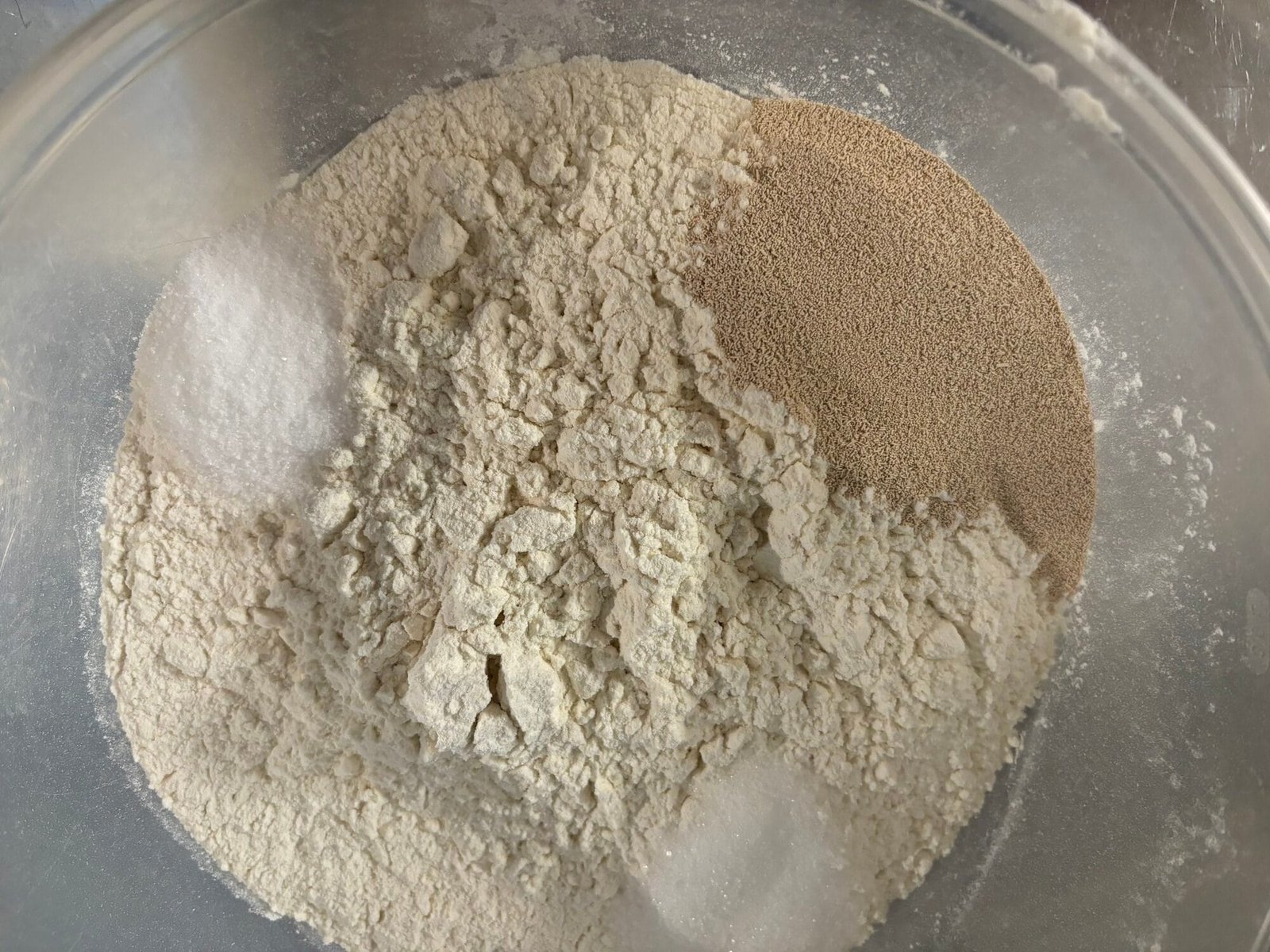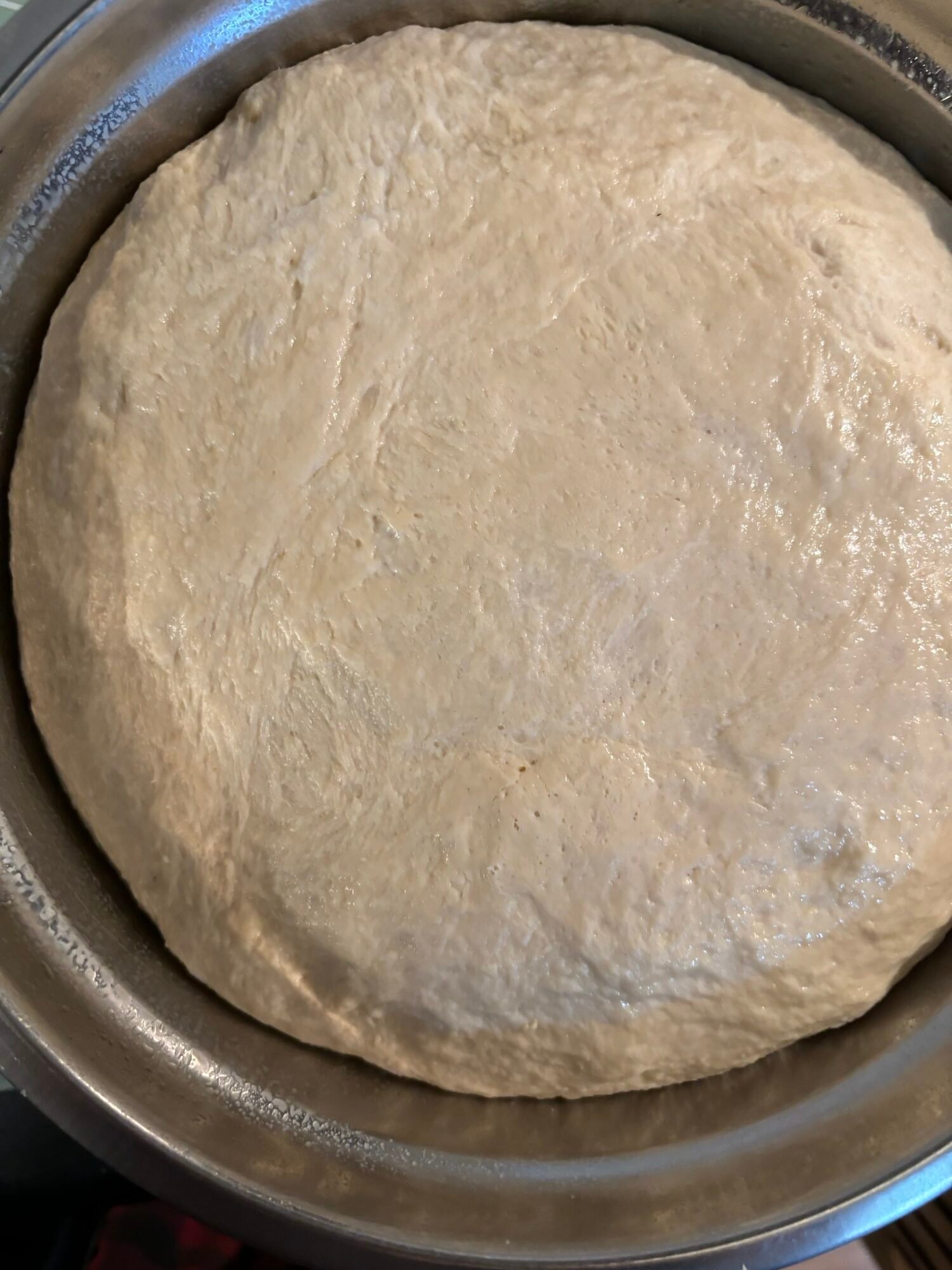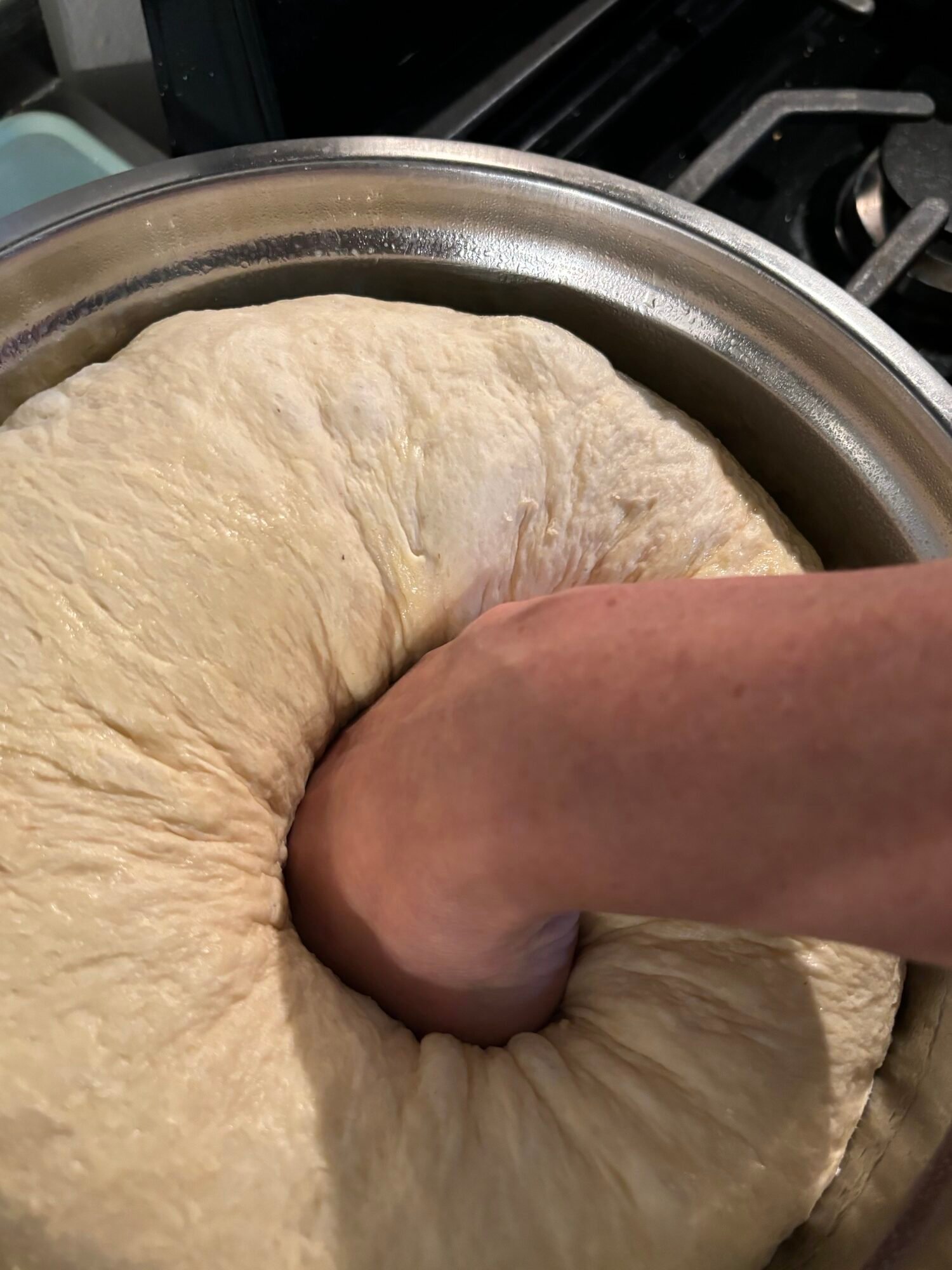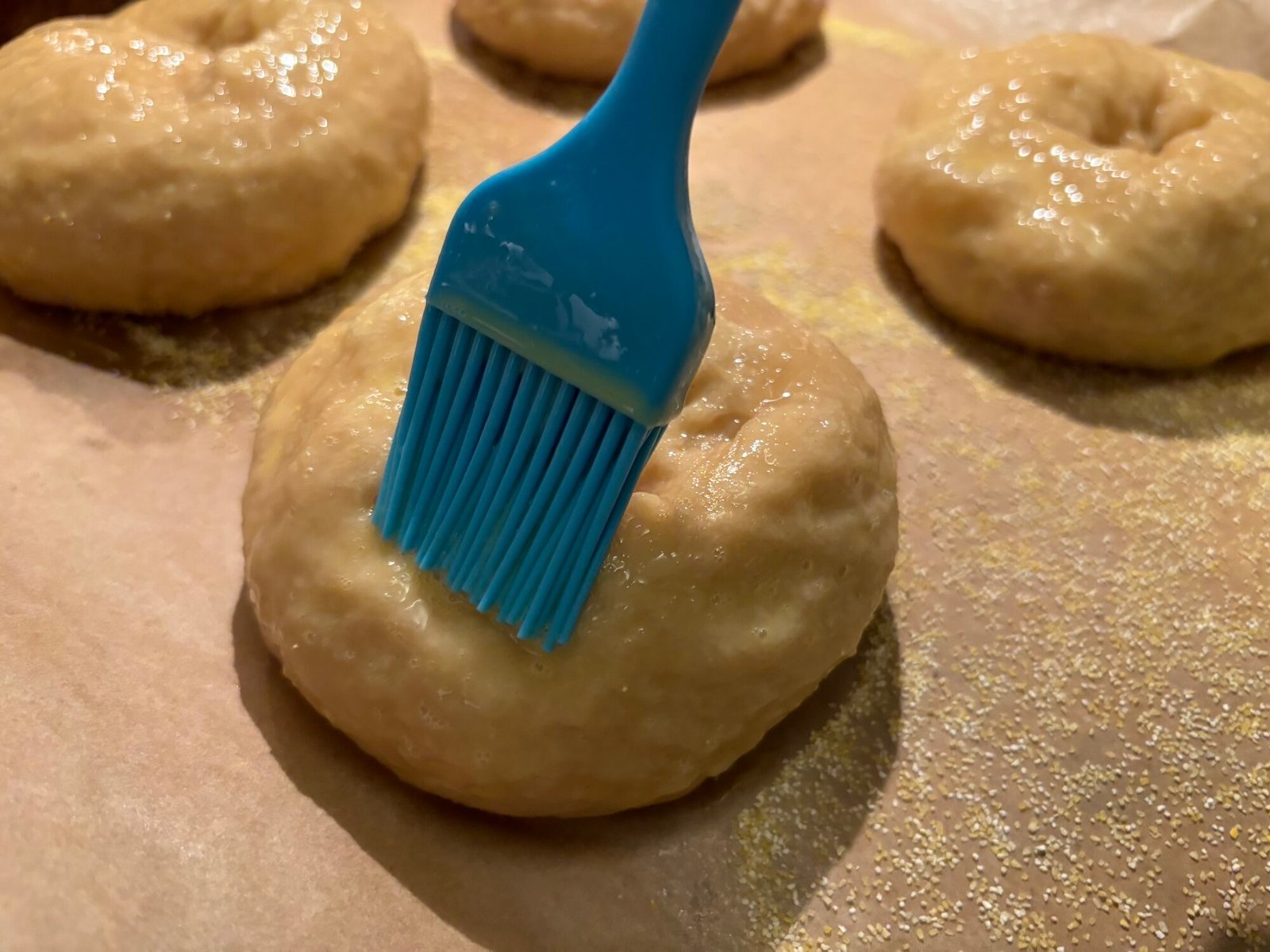There’s something incredibly satisfying about
homemade bagels, especially when they’re warm and fresh out of the oven. New York-style bagels are known for their
chewy texture,
crispy exterior, and golden, shiny crust, and with the right technique and ingredients, you can make these iconic bagels right at home. This recipe uses
high-gluten bread flour,
rapid-rise yeast, and a touch of
barley malt syrup to create a dough that yields the perfect bagel—crisp on the outside, soft and chewy on the inside.
Whether you want
fresh bagels in the morning, or want to
make them ahead of time for a quick breakfast or snack, this recipe includes helpful tips for overnight proofing and even freezing. Read on for all the details, including tips for various toppings, substitutions, and special tools to make the process as smooth as possible.

Why High-Gluten Bread Flour and Rapid-Rise Yeast For Bagels?
High-Gluten Bread Flour
The foundation of a great bagel is the right flour. High-gluten bread flour is key because of its high protein content, which contributes to the chewy texture and dense structure of traditional New York-style bagels. If you substitute with all-purpose flour, you might end up with a softer bagel, which isn’t quite what we’re going for here. So, if you want authentic bagels, bread flour is a must.
Rapid-Rise Yeast
Unlike active dry yeast, which needs to be proofed in warm water before use, rapid-rise yeast (also known as instant yeast) can be added directly to the dry ingredients. This makes the dough-making process quicker, reducing waiting time without compromising on the flavor. If you use active dry yeast, you’ll need to allow more time for the dough to rise (about 2 hours). Either way, this recipe works with both types of yeast.
Ingredients You’ll Need:
Here’s what you’ll need to make your New York-style bagels:
- High-gluten bread flour – This flour has a higher protein content than regular all-purpose flour, helping to create that signature chewiness that’s characteristic of New York bagels.
- Rapid-rise yeast – This yeast activates quickly, eliminating the need for proofing, and helps the dough rise faster.
- Luke warm water (about 105°F to 115°F) – While you won’t need to proof the yeast, the warm water helps hydrate the dough and activate the yeast.
- Fine-grain sea salt – For flavor and to balance the sweetness of the barley malt.
- Barley malt (or barley malt syrup) – Adds sweetness to the dough and helps create the crispy, shiny crust that’s so essential to New York-style bagels

How to Make New York-Style Bagels
Step 1: Mix the Dough
In a large bowl, combine the bread flour, rapid-rise yeast, granulated sugar and fine-grain sea salt, do not directly combine the yeast together place on opposite sides of the bowl as this may deactivate the yeast.
Dissolve the barley malt in the lukewarm water and add to the dry ingredients, mix until a dough forms. If you’re using a stand mixer with a dough hook, mix on low speed for 5-6 minutes, or until the dough is smooth and elastic. If mixing by hand, knead the dough on a floured surface for 6-8 minutes.
The dough should be firm, slightly tacky but not overly sticky. If it's too sticky, add a bit more flour until the desired consistency is reached.
Step 2: First Rise
After mixing, cover the dough with a clean kitchen towel or plastic wrap. Let it rise at room temperature for 45-60 minutes, or until it has doubled in size. This first rise helps the dough develop its flavor and texture.
Step 3: Shape the Bagels
Once the dough has doubled in size, punch it down to release any air bubbles. Turn the dough out onto a clean surface and divide it into 8 equal portions.
Roll each piece into a smooth ball, then use your thumb to create a hole in the center of each ball. Stretch the hole until it’s about 1 to 1.5 inches wide. If the dough resists stretching, let it rest for a few minutes to relax before continuing.
Overnight Method
For overnight proofing to achieve warm bagels in the morning, I prefer this method: After the first rise, shape the bagels and cover them tightly with plastic wrap before refrigerating them. This helps them maintain their shape and allows for a slow rise in the fridge overnight, resulting in a more flavorful bagel.
Quick Rise (Same Day)
If you're short on time, cover the dough and let it rise at room temperature for 1-2 hours, or until it doubles in size. This method is quicker, but the flavor may not be as complex as the overnight rise.
Step 4: Boil the Bagels
Bring a large pot of water to a boil. Add 1 tablespoon of barley malt syrup (or honey) to the water to help create a chewy texture and a glossy finish. Reduce the heat to a simmer.
Working in batches, carefully drop the shaped bagels into the simmering water. Boil each bagel for 45 seconds per side. This step is essential for achieving the chewy texture and golden color you expect from a perfect bagel. Place on a cooling rack while you finish batches. Once batches are complete, transfer the bagels to a parchment-lined baking sheet dusted with cornmeal.
Step 5: Add Toppings & Bake
Brush the bagels with a light egg wash (1 egg whisked with 1 tablespoon of water) to enhance the golden color. Add your favorite toppings, like sesame seeds, poppy seeds, or everything bagel seasoning.
Bake the bagels in a preheated oven at 425°F (220°C) for 18-22 minutes, or until golden brown. You can rotate the baking sheet halfway through for even browning. The bagels should be crispy on the outside, and soft and chewy on the inside.
Step 6: Enjoy
Allow the bagels to cool for a few minutes before slicing. Serve them warm with your favorite toppings
Make-Ahead Tips
Overnight Make-Ahead Instructions
For fresh bagels in the morning, shape the bagels after the first rise, cover them tightly with plastic wrap, and refrigerate them overnight for 12-16 hours. In the morning, remove the dough from the fridge and let it come to room temperature for 45 minutes before boiling and baking.
Freezing Make-Ahead Instructions
Baked bagels freeze wonderfully! After they’ve cooled completely, store them in an airtight container or freezer bag for up to 3 months. To reheat, simply thaw them in the refrigerator overnight and warm them in the oven or toast them.
You can also freeze the bagel dough before boiling. After punching the dough down in Step 3, wrap it tightly in plastic wrap, then cover it with aluminum foil. Freeze for up to 3 months. When you're ready to bake, thaw the dough overnight in the refrigerator, punch it down to release any air bubbles, and continue with Step 3.
I hope you enjoy making and savoring these homemade New York-style bagels as much as I do! Whether you’re indulging in a classic schmear of cream cheese or experimenting with your favorite toppings, these bagels are sure to impress. The best part? You can adapt them to your taste and make them your own!
If you try the recipe, I’d love to hear about your experience. Share your bagel-making adventures in the comments below, or tag me on social media with your bagel creations! Don't forget to share this recipe with friends and family who might also want to enjoy a taste of homemade bagels. Happy baking!
Feel free to leave a comment or ask any questions—you know I love hearing from you!



 In a large mixing bowl, combine the bread flour, rapid-rise yeast, granulated sugar, and fine-grain sea salt, ensuring that the yeast and salt do not come into direct contact, as this may deactivate the yeast.
In a large mixing bowl, combine the bread flour, rapid-rise yeast, granulated sugar, and fine-grain sea salt, ensuring that the yeast and salt do not come into direct contact, as this may deactivate the yeast.  Dissolve the barley malt in lukewarm water, and subsequently add this mixture to the dry ingredients. Mix until a cohesive dough forms. If utilizing a stand mixer equipped with a dough hook, operate at a low speed for 5 to 6 minutes, or until the dough attains a smooth and elastic texture. If preparing by hand, knead the dough on a floured surface for 6 to 8 minutes.
Dissolve the barley malt in lukewarm water, and subsequently add this mixture to the dry ingredients. Mix until a cohesive dough forms. If utilizing a stand mixer equipped with a dough hook, operate at a low speed for 5 to 6 minutes, or until the dough attains a smooth and elastic texture. If preparing by hand, knead the dough on a floured surface for 6 to 8 minutes.  The dough should exhibit firmness, possessing a slight tackiness without being overly sticky. Should the dough appear too sticky, incorporate additional flour incrementally by teaspoon until the desired consistency is achieved.
The dough should exhibit firmness, possessing a slight tackiness without being overly sticky. Should the dough appear too sticky, incorporate additional flour incrementally by teaspoon until the desired consistency is achieved. Place the dough in a well-oiled bowl, cover the dough with a clean kitchen towel or plastic wrap. Allow it to rise at room temperature for a duration of 45 to 60 minutes, or until it has approximately doubled in size. This initial fermentation is critical for the development of both flavor and texture within the dough.
Place the dough in a well-oiled bowl, cover the dough with a clean kitchen towel or plastic wrap. Allow it to rise at room temperature for a duration of 45 to 60 minutes, or until it has approximately doubled in size. This initial fermentation is critical for the development of both flavor and texture within the dough. After the dough has doubled in size, gently deflate it to release any trapped air bubbles. Transfer the dough to a clean surface and divide it into eight equal portions.
After the dough has doubled in size, gently deflate it to release any trapped air bubbles. Transfer the dough to a clean surface and divide it into eight equal portions.  Shape each piece into a smooth ball, then utilize your thumb to create a hole at the center of each ball. Gradually stretch the hole until its diameter measures approximately 1 to 1.5 inches. Should the dough resist this stretching, allow it to rest for a few minutes to facilitate relaxation before proceeding.
Shape each piece into a smooth ball, then utilize your thumb to create a hole at the center of each ball. Gradually stretch the hole until its diameter measures approximately 1 to 1.5 inches. Should the dough resist this stretching, allow it to rest for a few minutes to facilitate relaxation before proceeding. Overnight Method: following the initial rise, shape the bagels, place them on a parchment lined cookie sheet, and cover them securely with plastic wrap before placing them in the refrigerator. This process will help maintain their shape while allowing for a gradual rise throughout the night, resulting in enhanced flavor in the bagels.
Overnight Method: following the initial rise, shape the bagels, place them on a parchment lined cookie sheet, and cover them securely with plastic wrap before placing them in the refrigerator. This process will help maintain their shape while allowing for a gradual rise throughout the night, resulting in enhanced flavor in the bagels. Working in batches, carefully immerse the formed bagels into the simmering water. Boil each bagel for 45 seconds on each side. This step is essential for creating the characteristic chewy texture and golden color associated with high-quality bagels.
Working in batches, carefully immerse the formed bagels into the simmering water. Boil each bagel for 45 seconds on each side. This step is essential for creating the characteristic chewy texture and golden color associated with high-quality bagels.  Apply a light egg wash (comprising one whisked egg combined with one tablespoon of water) to the bagels to enhance the golden hue. Add preferred toppings, such as sesame seeds, poppy seeds, or an everything bagel seasoning blend.
Apply a light egg wash (comprising one whisked egg combined with one tablespoon of water) to the bagels to enhance the golden hue. Add preferred toppings, such as sesame seeds, poppy seeds, or an everything bagel seasoning blend.  Bake the bagels in a preheated oven at 425°F (220°C) for a duration of 18 to 22 minutes, or until they exhibit a golden-brown color. It is advisable to rotate the baking sheet halfway through the baking process to ensure even browning. The resulting bagels should present a crispy exterior while retaining a soft, chewy interior.
Bake the bagels in a preheated oven at 425°F (220°C) for a duration of 18 to 22 minutes, or until they exhibit a golden-brown color. It is advisable to rotate the baking sheet halfway through the baking process to ensure even browning. The resulting bagels should present a crispy exterior while retaining a soft, chewy interior.